Abstract
The surgical approach to lung resections is evolving constantly. Since the video-assisted thoracoscopic surgery (VATS) anatomic lobectomy for lung cancer was described two decades ago, many units have successfully adopted this technique. The VATS lobectomy can be defined as the individual dissection of veins, arteries and bronchus, with a mediastinal lymphadenectomy, using a videothoracoscopic approach visualized on screen and involving 2 to 4 incisions or ports, with no rib spreading. However, the surgery can be performed by only one incision with similar outcomes. Since 2010, when the uniportal approach was introduced for major pulmonary resections, the technique has been spreading worldwide. This technique provides a direct view of the target tissue. The parallel instrumentation achieved during the single-port approach mimics the maneuvers performed during open surgery. It represents a less invasive approach than the multiport technique, and minimizes the compression of the intercostal nerve. As the surgeon’s experience with the uniportal VATS lobectomy grows, more complex cases can be performed by using this approach, thus expanding the indications for single-incision thoracoscopic lobectomy.
Keywords: Minimally invasive surgery, video-assisted thoracic surgery (VATS), single-port lobectomy, uniportal video-assisted thoracic surgical resections
Introduction
The uniportal access was initially described by Rocco et al., firstly for the management of minor procedures (1). Since 2010, when the uniportal approach was introduced for major pulmonary resections, the technique has been spreading worldwide.
This technique provides a direct view of the target tissue. The parallel instrumentation achieved during the single-port approach mimics the maneuvers performed during open surgery (1-3).
It represents a less invasive approach than the multiport technique, and minimizes the compression of the intercostal nerve.
The aim of this chapter is to establish the most important steps of the uniportal lobectomy and to reveal some useful tricks to perform the technique.
Operative technique
General aspects
Single-incision video-assisted thoracic surgery (VATS) lobectomy follows the oncological principles of major pulmonary resections by VATS: individual dissection of veins, arteries and lobar bronchus, likewise complete mediastinal lymphadenectomy with a video-assisted thoracoscopic approach, with no rib spreading (2-4). The procedure is performed by video-visualization.
The utility incision is usually placed in the 5th intercostal space. The proper placement of the incision is crucial for good access to upper hilar structures and lymph node stations. No trocar and no rib spreader are required.
One of the key points is the adequate exposure of the lung, which is mandatory for every step. Also, the rotation of the surgical table and the correct retraction of the parenchyma are essential to improve the exposure and to obtain different angles of view. Another key point is the bimanual instrumentation.
This approach provides a direct visualization of the target tissue (5). In addition, the surgeon and the assistant are placed in front of the patient, so they have the same field of vision and the coordination is better.
For most of the surgical steps, the thoracoscope is usually placed at the posterior part of the utility incision, working with the instruments in the anterior part (Figure 1).
Figure 1.
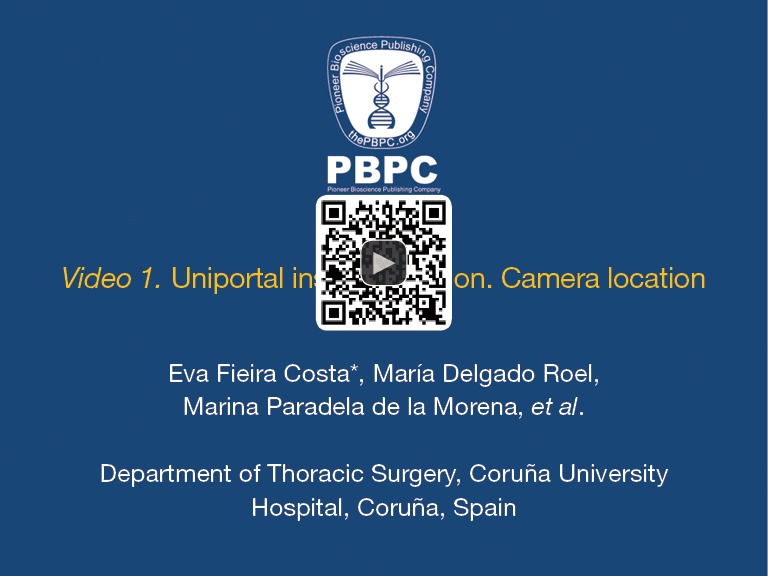
Uniportal instrumentation. Camera location (6). Available online: http://www.asvide.com/articles/327
Finally, the use of specific equipment (such as a 30º thoracoscope, instruments with proximal and distal articulation, energy devices, articulated staplers or vascular clips) is recommended (2,3). In fact, the use of vascular clips for proximal vascular control and energy devices for distal division of small vascular branches is recommended (Figure 2).
Figure 2.
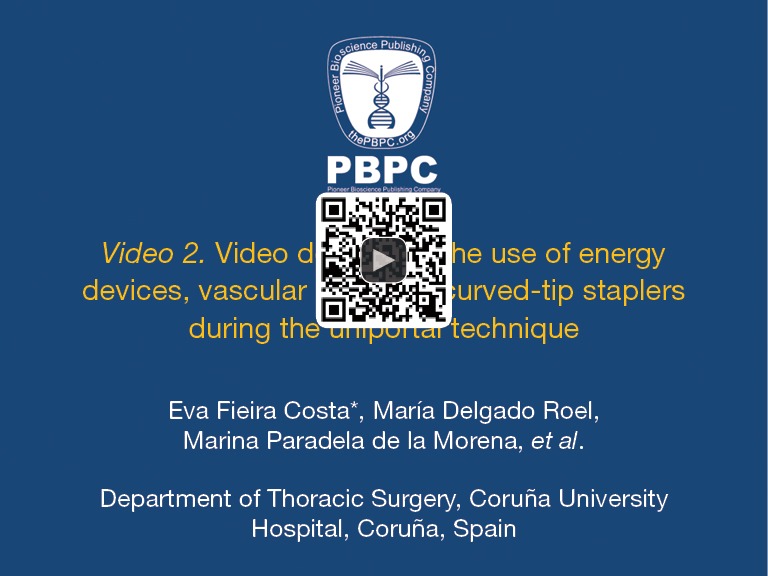
Video describing the use of energy devices, vascular clips and curved-tip staplers during the uniportal technique (7). Available online: http://www.asvide.com/articles/328
Lower lobectomy
The technique is different depending on whether the fissure is complete or not:
If the fissure is complete, the sequence is as follows: artery, pulmonary ligament, vein, bronchus and fissure;
In the fissureless-technique, the sequence could be: pulmonary ligament, vein, bronchus, artery and fissure. Another way would be starting the procedure by dividing the anterior portion of the fissure from the hilum, after the identification of the interlobar artery (the anvil of the stapler should be placed over the surface of the artery).
In the video, there is an example of the fissureless technique performing a left lower lobectomy, from down to up (Figure 3). After retracting the lower lobe posteriorly and superiorly, the vein can be dissected using the right angle clamp, so the stapler goes easily into place.
Figure 3.
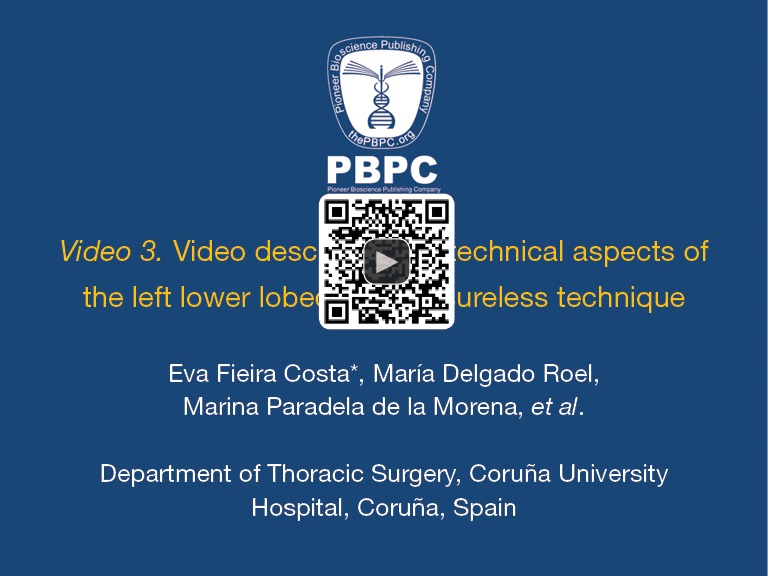
Video describing the technical aspects of the left lower lobectomy: fissureless technique (8). Available online: http://www.asvide.com/articles/329
The most difficult step during this lobectomy is the dissection of the bronchus; care must be taken in order to avoid injuries in the basilar artery. An optimal plane must be created between the bronchus and the artery, to staple without tractions. Once the bronchus is transected, the artery can be divided. The last step is to complete the fissure.
On the right side, the right lower lobectomy is very similar. As in this video (Figure 4), firstly the pulmonary ligament is cut and the vein is dissected and stapled. In this case, the fissure is complete, so the artery can be easily exposed and divided. Sometimes, it is easier to divide the artery into basilar and superior segmental branches. Then the bronchus can be stapled; the last step is the fissure.
Figure 4.
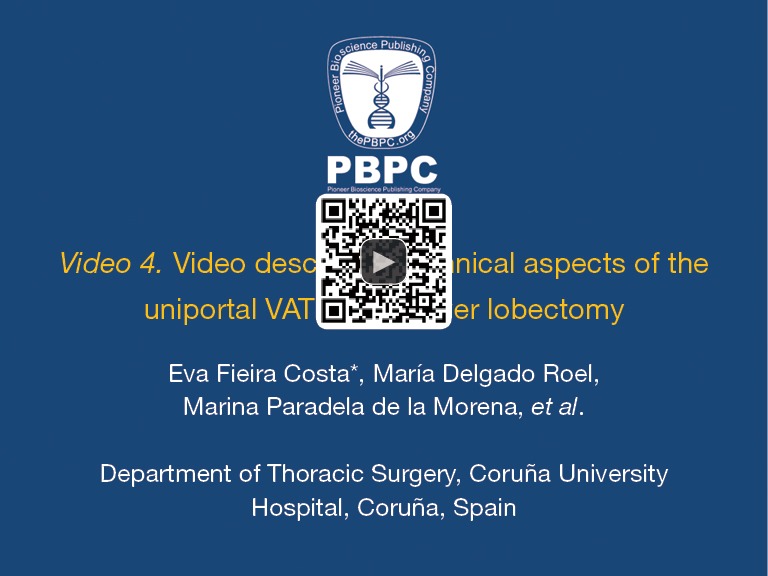
Video describing technical aspects of the uniportal VATS right lower lobectomy (9). Available online: http://www.asvide.com/articles/330
The sequence is different if a fissureless technique is performed: starting the procedure by cutting the pulmonary ligament and dissecting the vein. When the vein is divided, the bronchus is exposed and transected. Care must be taken to avoid injuring the bronchus or the artery of the middle lobe. After the section of the lower bronchus, the artery is identified and stapled. The fissure is the last step (Figure 5).
Figure 5.
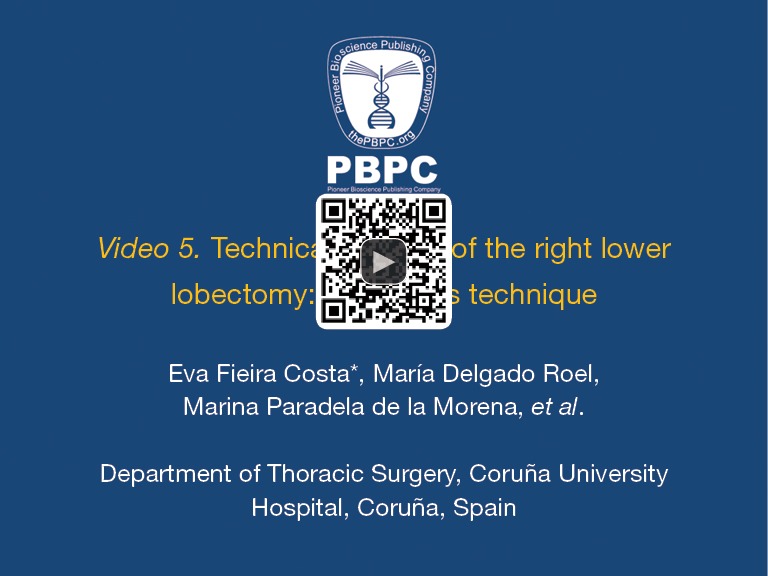
Technical aspects of the right lower lobectomy: fissureless technique (10). Available online: http://www.asvide.com/articles/331
Left upper lobectomy
Probably, this is the most difficult lobectomy using the uniportal approach, especially when the fissure is not complete (Figure 6). We recommend dividing the arterial trunks before dissecting the vein. Once the artery is divided, the vein can easily be exposed. It is very important to dissect the vein as distal as possible to improve the angle for the insertion of the stapler.
Figure 6.
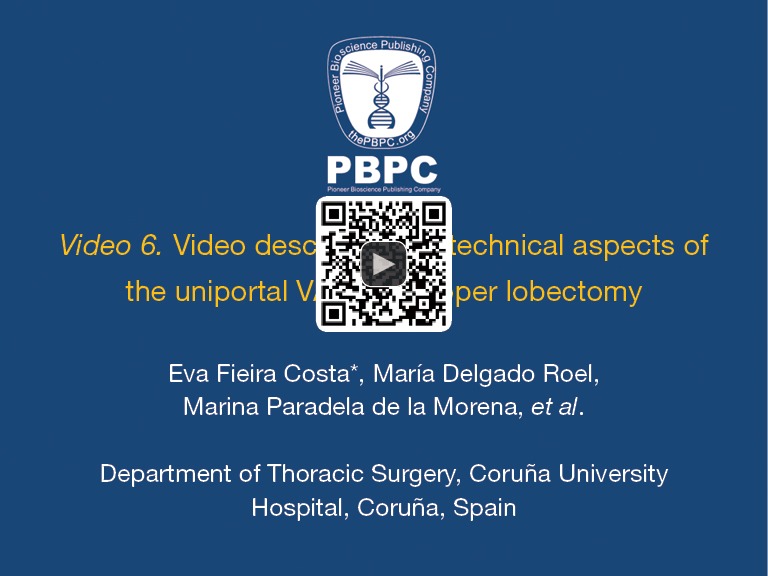
Video describing the technical aspects of the uniportal VATS left upper lobectomy (11). Available online: http://www.asvide.com/articles/332
During the management of the upper vein, we recommend stapling the anterior portion of the major fissure. At this point, the camera is placed in the anterior portion of the utility incision to provide a better view of the hilum. The use of tip-curved staplers is also recommended, to avoid major tractions.
When the remaining arterial branches are divided, the bronchus can be dissected. It can be transected at this point or left for the final step. In this video (Figure 6), we were able to identify the interlobar artery in the fissure; so the anvil of the stapler is placed over the surface of the interlobar artery and the fissure can then be stapled; it is the safest management of the fissure, avoiding vascular events. After this step, the fissure is completed and the bronchus divided.
Focusing on the management of the left upper bronchus, there are four different approaches to the bronchus transection (Figure 7):
Figure 7.
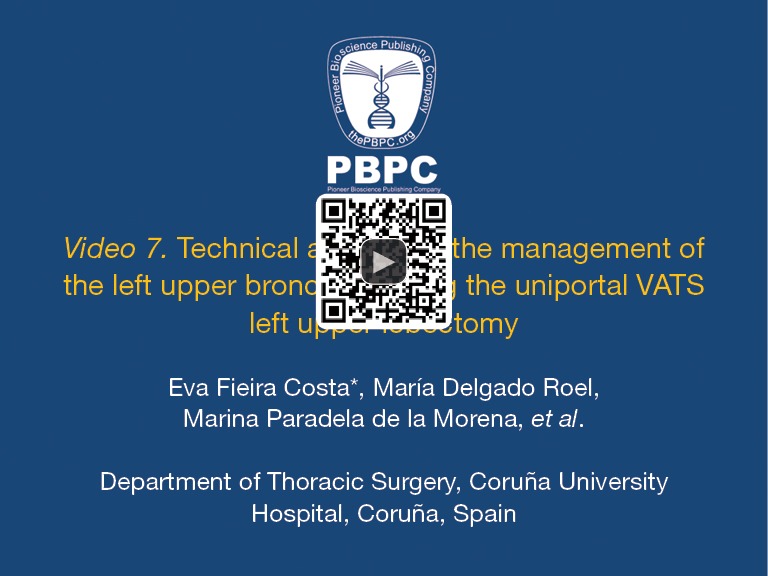
Technical aspects of the management of the left upper bronchus during the uniportal VATS left upper lobectomy (12). Available online: http://www.asvide.com/articles/333
When the fissure is complete or the artery can be easily exposed, we recommend dividing the lingular artery in the fissure, and then the bronchus;
If the fissure is not complete or the artery is hidden, a TA stapler can be used to divide it;
Another way is the use of scissors and to close it later (using a stapler or manual suture);
Finally, during the fissureless-technique, when the arteries and the vein have been stapled, the bronchus can be transected using an Endostapler. We only recommend this way for experienced VATS surgeons.
Right upper lobectomy
The steps for this lobectomy are very similar to those on the left side (Figure 8).
Figure 8.
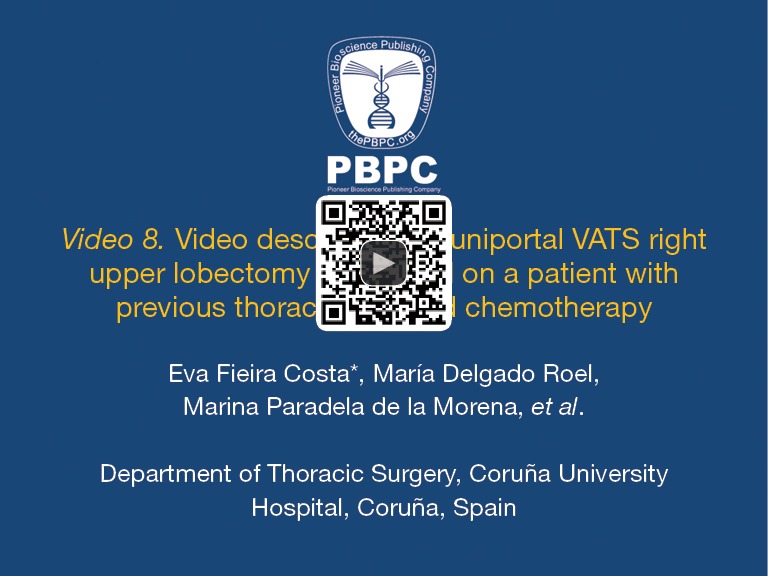
Video describing the uniportal VATS right upper lobectomy performed on a patient with previous thoracotomy and chemotherapy (13). Available online: http://www.asvide.com/articles/334
We recommend starting the procedure by dividing the anterior arterial trunk and then the vein. If the angle is no good, stapling the anterior portion of the minor fissure can provide a better retraction of the lobe, thus improving the angle.
When the artery and the vein are transected, the bronchus is divided and stapled and finally, the fissure. This last step is performed by placing the anvil of the stapler over the surface of the interlobar artery.
During the approach to the minor fissure, the camera is placed in the anterior portion of the utility incision and the instruments at the posterior. Perhaps, this is the only step in which the camera position is changed, but it provides a direct view of the hilum.
Middle lobe lobectomy
This lobectomy is usually performed from bottom to top. The sequence is as follows: anterior portion of the major fissure, vein, bronchus, artery and finally, the remaining fissure. Only when the fissure is complete or the artery can be easily exposed, the artery can be divided before the bronchus (Figure 9).
Figure 9.
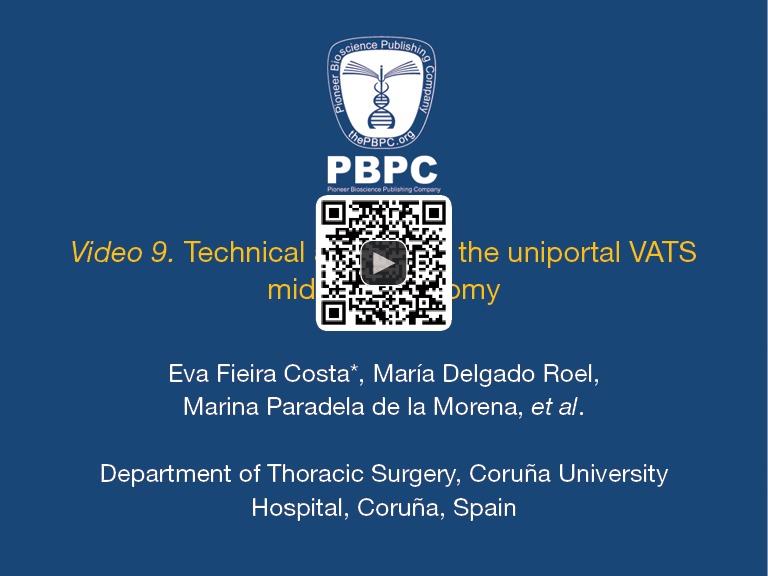
Technical aspects of the uniportal VATS middle lobectomy (14). Available online: http://www.asvide.com/articles/335
Due to the smaller branches, vascular clips are often used to divide the arterial branches in the middle lobectomy.
Comments
The uniportal lobectomy is a feasible, safe and an oncologic procedure in expert hands (4). To date, we have performed about 400 uniportal major pulmonary resections with good postoperative outcomes. Only one incision is used, which is less invasive than the multiportal technique. No trocar is used, so there could mean less compression to the intercostal nerve. The instrumentation is more anatomic and the visualization of the target is direct (5).
Acknowledgements
Disclosure: The authors declare no conflict of interest.
References
- 1.Rocco G.One-port (uniportal) video-assisted thoracic surgical resections--a clear advance. J Thorac Cardiovasc Surg 2012;144:S27-31. [DOI] [PubMed] [Google Scholar]
- 2.Gonzalez-Rivas D, Fernandez R, de la Torre M, et al. Thoracoscopic lobectomy through a single incision. Multimed Man Cardiothorac Surg 2012;2012:mms007. [DOI] [PubMed]
- 3.Gonzalez-Rivas D, Fieira E, Delgado M, et al. Uniportal video-assisted thoracoscopic lobectomy. J Thorac Dis 2013;5Suppl 3:S234-45. [DOI] [PMC free article] [PubMed] [Google Scholar]
- 4.Gonzalez-Rivas D, Paradela M, Fernandez R, et al. Uniportal video-assisted thoracoscopic lobectomy: two years of experience. Ann Thorac Surg 2013;95:426-32. [DOI] [PubMed] [Google Scholar]
- 5.Bertolaccini L, Rocco G, Viti A, Terzi A.Geometrical characteristics of uniportal VATS. J Thorac Dis 2013;5Suppl 3:S214-6. [DOI] [PMC free article] [PubMed] [Google Scholar]
- 6.Fieira Costa E, Delgado Roel M, Paradela de la Morena M, et al. Uniportal instrumentation. Camera location. Asvide 2014;1:314. Available online: http://www.asvide.com/articles/327
- 7.Fieira Costa E, Delgado Roel M, Paradela de la Morena M, et al. Video describing the use of energy devices, vascular clips and curved-tip staplers during the uniportal technique. Asvide 2014;1:315. Available online: http://www.asvide.com/articles/328
- 8.Fieira Costa E, Delgado Roel M, Paradela de la Morena M, et al. Video describing the technical aspects of the left lower lobectomy: fissureless technique. Asvide 2014;1:316. Available online: http://www.asvide.com/articles/329
- 9.Fieira Costa E, Delgado Roel M, Paradela de la Morena M, et al. Video describing technical aspects of the uniportal VATS right lower lobectomy. Asvide 2014;1:317. Available online: http://www.asvide.com/articles/330
- 10.Fieira Costa E, Delgado Roel M, Paradela de la Morena M, et al. Technical aspects of the right lower lobectomy: fissureless technique. Asvide 2014;1:318. Available online: http://www.asvide.com/articles/331
- 11.Fieira Costa E, Delgado Roel M, Paradela de la Morena M, et al. Video describing the technical aspects of the uniportal VATS left upper lobectomy. Asvide 2014;1:319. Available online: http://www.asvide.com/articles/332
- 12.Fieira Costa E, Delgado Roel M, Paradela de la Morena M, et al. Technical aspects of the management of the left upper bronchus during the uniportal VATS left upper lobectomy. Asvide 2014;1:320. Available online: http://www.asvide.com/articles/333
- 13.Fieira Costa E, Delgado Roel M, Paradela de la Morena M, et al. Video describing the uniportal VATS right upper lobectomy performed on a patient with previous thoracotomy and chemotherapy. Asvide 2014;1:321. Available online: http://www.asvide.com/articles/334
- 14.Fieira Costa E, Delgado Roel M, Paradela de la Morena M, et al. Technical aspects of the uniportal VATS middle lobectomy. Asvide 2014;1:322. Available online: http://www.asvide.com/articles/335


